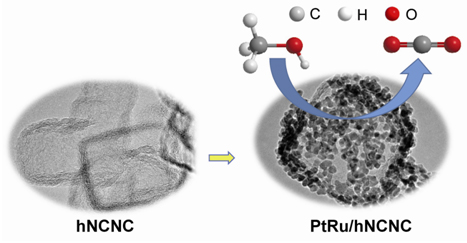| [1] Chen, A.; Holt-Hindle, P. Chem. Rev. 2010, 110, 3767.
[2] Kakati, N.; Maiti, J.; Lee, S. H.; Jee, S. H.; Viswanathan, B.; Yoon, Y. S. Chem. Rev. 2014, 114, 12397.
[3] Gasteiger, H. A.; Markovic, N.; Ross, P. N.; Cairns, E. J. J. Phys. Chem. 1994, 98, 617.
[4] Liu, Z. L.; Guo, B.; Hong, L.; Lim, T. H. Electrochem. Commun. 2006, 8, 83.
[5] Pereira, L. G. S.; dos Santos, F. R.; Pereira, M. E.; Paganin, V. A.; Ticianelli, E. A. Electrochim. Acta 2006, 51, 4061.
[6] Sun, J.; Ma, H.; Jiang, H.; Dang, L.; Lu, Q.; Gao, F. J. Mater. Chem. 2015, 3, 15882.
[7] Mylswamy, S.; Wang, C. Y.; Liu, R. S.; Lee, J. F.; Tang, M. J.; Lee, J. J.; Weng, B. J. Chem. Phys. Lett. 2005, 412, 444.
[8] Watanabe, M.; Motoo, S. J. Electroanal. Chem. Interfacial Electrochem. 1975, 60, 267.
[9] Yue, B.; Ma, Y. W.; Tao, H. S.; Yu, L. S.; Jian, G. Q.; Wang, X. Z.; Wang, X. S.; Lu, Y. N.; Hu, Z. J. Mater. Chem. 2008, 18, 1747.
[10] Jiang, S.; Zhu, L.; Ma, Y.; Wang, X.; Liu, J.; Zhu, J.; Fan, Y.; Zou, Z.; Hu, Z. J. Power Sources 2010, 195, 7578.
[11] Feng, H.; Ma, J.; Hu, Z. J. Mater. Chem. 2010, 20, 1702.
[12] Joo, S. H.; Kwon, K.; You, D. J.; Pak, C.; Chang, H.; Kim, J. M. Electrochim. Acta 2009, 54, 5746.
[13] Guerrero-Ruiz, A.; Badenes, P.; Rodriguez-Ramos, I. Appl. Catal. A: Gen. 1998, 173, 313.
[14] Kuang, Y.; Cui, Y.; Zhang, Y.; Yu, Y.; Zhang, X.; Chen, J. Chem. Eur. J. 2012, 18, 1522.
[15] Che, G.; Lakshmi, B. B.; Fisher, E. R.; Martin, C. R. Nature 1998, 393, 346.
[16] Lin, M. L.; Huang, C. C.; Lo, M. Y.; Mou, C. Y. J. Phys. Chem. C 2008, 112, 867.
[17] Liu, Z.; Su, F.; Zhang, X.; Tay, S. W. ACS Appl. Mater. Interfaces 2011, 3, 3824.
[18] Yu, J. S.; Kang, S.; Yoon, S. B.; Chai, G. J. Am. Chem. Soc. 2002, 124, 9382.
[19] Li, F.; Chan, K.-Y.; Yung, H.; Yang, C.; Ting, S. W. Phys. Chem. Chem. Phys. 2013, 15, 13570.
[20] Cong, H.-P.; Ren, X.-C.; Yu, S.-H. ChemCatChem 2012, 4, 1555.
[21] Bin, D.; Ren, F.; Wang, H.; Zhang, K.; Yang, B.; Zhai, C.; Zhu, M.; Yang, P.; Du, Y. RSC Adv. 2014, 4, 39612.
[22] La-Torre-Riveros, L.; Guzman-Blas, R.; Méndez-Torres, A. E.; Prelas, M.; Tryk, D. A.; Cabrera, C. R. ACS Appl. Mater. Interfaces 2012, 4, 1134.
[23] Jiang, S.; Ma, Y.; Jian, G.; Tao, H.; Wang, X.; Fan, Y.; Lu, Y.; Hu, Z.; Chen, Y. Adv. Mater. 2009, 21, 4953.
[24] Chen, S.; Bi, J.; Zhao, Y.; Yang, L.; Zhang, C.; Ma, Y.; Wu, Q.; Wang, X.; Hu, Z. Adv. Mater. 2012, 24, 5593.
[25] Xie, K.; Qin, X.; Wang, X.; Wang, Y.; Tao, H.; Wu, Q.; Yang, L.; Hu, Z. Adv. Mater. 2012, 24, 347.
[26] Jiang, Y.; Yang, L.; Sun, T.; Zhao, J.; Lyu, Z.; Zhuo, O.; Wang, X.; Wu, Q.; Ma, J.; Hu, Z. ACS Catal. 2015, 5, 6707.
[27] Lyu, Z.; Xu, D.; Yang, L.; Che, R.; Feng, R.; Zhao, J.; Li, Y.; Wu, Q.; Wang, X.; Hu, Z. Nano Energy 2015, 12, 657.
[28] Zhao, J.; Lai, H.; Lyu, Z.; Jiang, Y.; Xie, K.; Wang, X.; Wu, Q.; Yang, L.; Jin, Z.; Ma, Y.; Liu, J.; Hu, Z. Adv. Mater. 2015, 27, 3541.
[29] Lyu, Z.; Feng, R.; Zhao, J.; Fan, H.; Xu, D.; Wu, Q.; Yang, L.; Chen, Q.; Wang, X.; Hu, Z. Acta Chim. Sinica 2015, 73, 1013. (吕之阳, 冯瑞, 赵进, 范豪, 徐丹, 吴强, 杨立军, 陈强, 王喜章, 胡征, 化学学报, 2015, 73, 1013.)
[30] Feng, R.; Wang, L.; Lyu, Z.; Wu, Q.; Yang, L.; Wang, X.; Hu, Z. Acta Chim. Sinica 2014, 72, 653. (冯瑞, 王立伟, 吕之阳, 吴强, 杨立军, 王喜章, 胡征, 化学学报, 2014, 72, 653.)
[31] Prabhuram, J.; Zhao, T. S.; Liang, Z. X.; Chen, R. Electrochim. Acta 2007, 52, 2649.
[32] Roth, C.; Benker, N.; Theissmann, R.; Nichols, R. J.; Schiffrin, D. J. Langmuir 2008, 24, 2191.
[33] Bock, C.; Paquet, C.; Couillard, M.; Botton, G. A.; MacDougall, B. R. J. Am. Chem. Soc. 2004, 126, 8028.
[34] Giorgi, L.; Pozio, A.; Bracchini, C.; Giorgi, R.; Turtù, S. J. Appl. Electrochem. 2001, 31, 325.
[35] Wang, Z.-C.; Ma, Z.-M.; Li, H.-L. Appl. Surf. Sci. 2008, 254, 6521.
[36] Liu, S.-H.; Yu, W.-Y.; Chen, C.-H.; Lo, A.-Y.; Hwang, B.-J.; Chien, S.-H.; Liu, S.-B. Chem. Mater. 2008, 20, 1622. |
